One of my favorite novels is Graham Greene’s Our Man in Havana. If you are not familiar with the basic plot, a British expatriate living in Havana, desperate for a little extra cash, passes off sketches of vacuum cleaner parts to MI6, claiming they depict a secret military installation in the mountains. (The screen grab, from Carol Reed’s cinematic adaptation, is from a magnificent blog post on the film from a design perspective.)
Greene had worked for British intelligence during the the war — his immediate supervisor was one Kim Philby — and he understood the perils of unreliable agents who tell their handlers what they wish to hear. I often think of those sketches of vacuum cleaners, rendered out of scale, when I contemplate how we think we know something about foreign nuclear or weapons program. Intelligence analysts and scholars alike must be careful to ensure that the evidence, not our assumptions, do the heavy lifting in any analysis. When assumptions do too much, the result is poor analysis. The mobile biological weapons trailers that some expected to find in Iraq after 2003 are an example of the sort of failure that occurs when analyst allow their assumptions to create a coherent picture out of noise.
This notion of balance is important because evidence, especially regarding foreign nuclear activities, is seldom complete and obvious. The evidence does not interpret itself. As I noted in my article examining the reasons for concern about Burma’s nuclear activities, some evidence is simply ambiguous. Perhaps I might have added that, in such cases, “I don’t know” is a responsible answer.
That is how I feel about the images provided by Sai Thein Win regarding the activities at two workshops, and at a remote jungle outpost near Thabeikyiin. (Remote jungle output is a bit of judgement, but it seems rather remote to me.)
Consider this an invitation to evaluate some of the equipment in light of possible uses in the extraction of rare earths. The major items are reduction vessels, glove boxes, bed reactors using Inconel ©, tube furnaces, cold traps, a burning chamber and a large mixer.
I am no expert on rare earths metallurgy! I am putting up this post largely to spur a discussion. Someone who actually understands the technology would be able to add quite a bit of refinement and point out, I am sure, quite a few errors. But it does seem to me that there is a non-nuclear weapons explanation for much of this equipment that requires a more expert eye than I have, even if this does not explain the curious presence of Dr. Ko Ko Oo in so many interesting places.
On a final note, Bertil Linter now claims that the Burmese approached the Indian nuclear program for assistance, but were turned down. Perhaps it is just a coincidence, but as I noted in my Foreign Policy piece, India uses rare earths extraction as a cover for its gas centrifuge program and the excellent resource, Extractive Metallurgy of Rare Earths, is authored by two dudes from BARC.
Bomb Reactors
The obvious place to start is the so-called “bomb reactors.” Bomb reactors is a terrible name, evoking nuclear bombs and nuclear reactors. These are perhaps better described as reduction vessels. (Frank Munger has a funny little post on this topic.)
Kelley and Fowle rightly observed that this equipment could be made to produce uranium metal. In addition to photos of the reduction vessel, Kelley and Fowle were shown a sketch of the vessel and a document requesting its production.
Albright and Walrond early on observed the existence of a patent for a very similar reduction vessel, which prompted their initial observation about the possible use for the extraction of rare earths.
I don’t need to tell you that Gupta and Krishnamurthy detail the use of reduction vessels in Extractive Metallurgy of Rare Earths.
Inert Atmosphere Glove Box
STW described the construction of a simple vacuum glove box produced at Factory 1 that “was used to mix two materials together when one of them was highly susceptible to oxidation. He describes evacuating the box and backfilling it with inert argon for the mixing to take place.” Kelley and Fowle are correct to note that the many uses of glove boxes.
Gupta and Krishnamurthy make reference to the use of glove boxes in Extractive Metallurgy of Rare Earths, although there are no pretty diagrams.
Ames Laboratory, however, posted the picture on the right on its website, captioned “Ames Lab technician Ross Anderson prepares to refine lanthanum by packing a tantalum crucible with lanthanum fluoride crystals and purified calcium in an argon-filled glovebox.”
Inconel Tube Fluoride Bed Reactor (Step 6)
Kelley and Fowle accurately observe that a reference to an alloy trademarked “Inconel” suggests the use of highly corrosive fluorine. An object is described as a “fluoride bed reactor.”
Bed reactors are used extensively in rare earths metallurgy. Fluoride is used in this process, and the bed reactors often have Inconel tubes. Here is a description and diagram of similar process, including the little trays that Kelley and Fowle observe:
Tube Furnaces
Kelley and Fowle believe that a number of tube furnaces may be for the “fluorination of solid uranium oxide powder to solid UF4powder. They are certainly tubes that have been heated and there are metal ‘boats’ for holding powder to be reacted.”
As the diagram above shows, similar processes are also used in the extraction of rare earths including trays and furnace tubes.
Nitrogen Tank with steel collectors (Step 6)
One last interesting piece of equipment observed by Kelley and Fowle is a nitrogen tank with steel collectors that appears to be a cold trap. Gupta and Krishnamurthy describe a similar device, although cooled with dry ice-acetone with instead of liquid nitrogen.
Other equipment
Kelley and Fowle note other items including a “Water Reduced Tank” that appears to be a large mixer, an “Automatic Autoclave Sterilizer”, and a “Burning Chamber”. As Kelley and Fowle note, these “are not particularly unique or part of the nuclear fuel cycle.” I would only add that they would not appear to be out of place in facility for rare earths extraction.
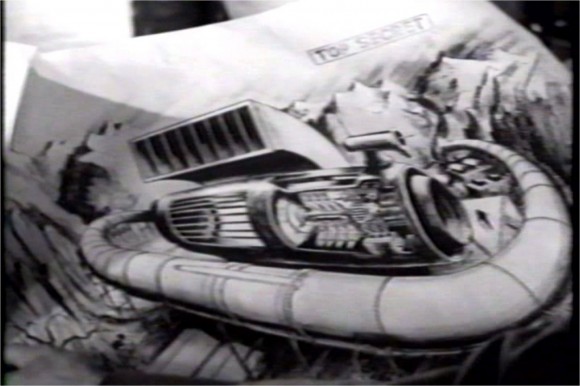

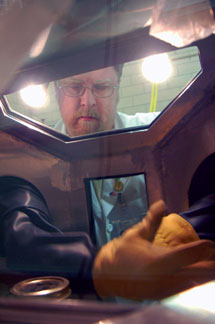
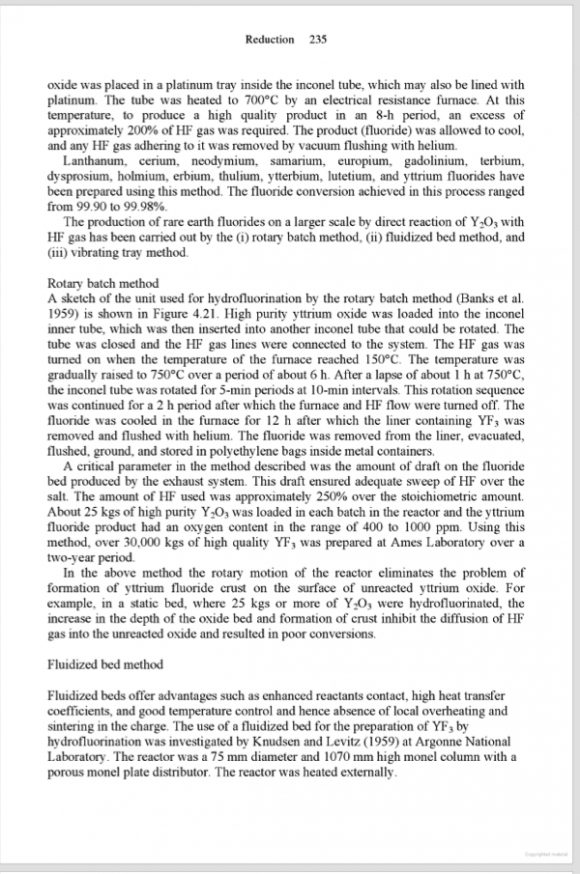
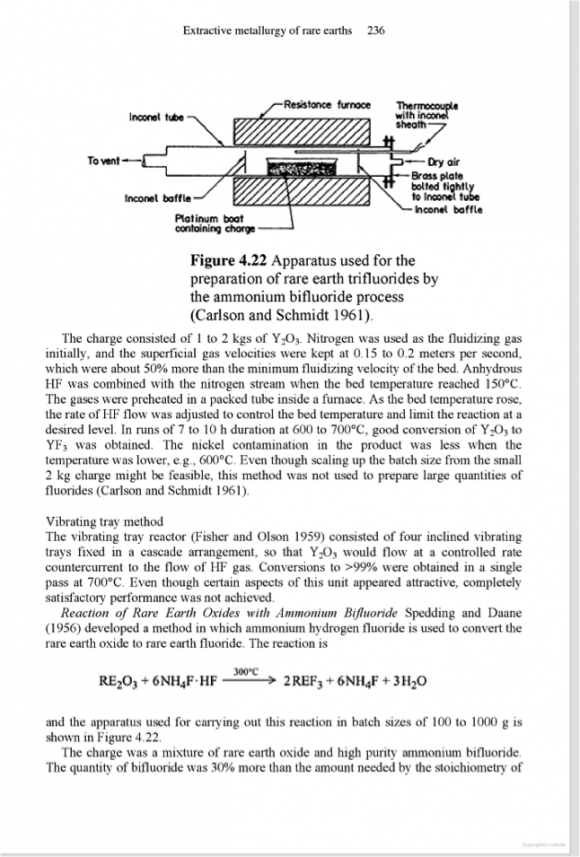
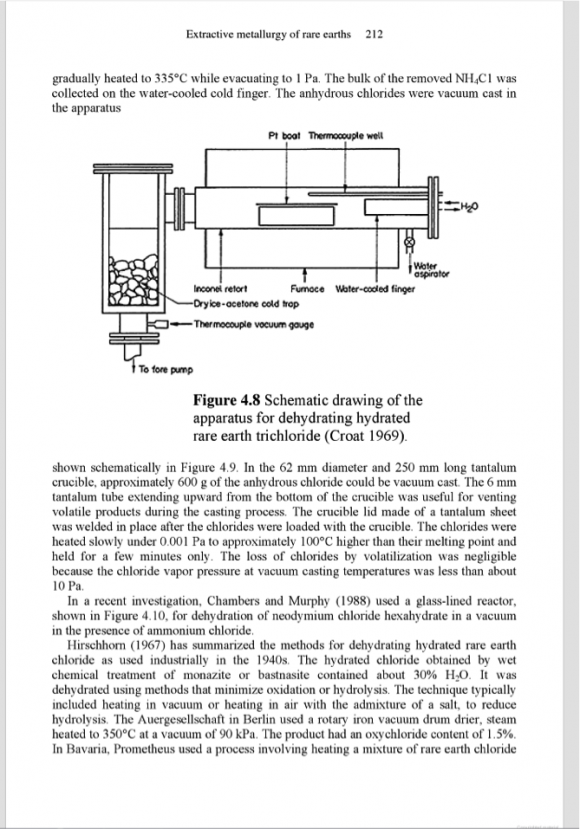

I am assuming making metal out of ores, and making flourides out of oxides is dual use technology where by one use is entirely legitimate. A lot has been made recently of China’s extensive deposits of rare earths (compared to the United States’ lesser supplies) and the rare earth use in sustainable electric vehicles, for example.
Could not Burma, which after all is near China, also be sitting on large ore supplies of rare earths and that this lab’s purpose is to make money by exploiting the material?
What signals or signs in the open literature do people have that this technology is being used for uranium or plutonium processing with potential nuclear weapons dimensions?
Just curious Wonks!
-Anon2
There is some evidence that Burma has rare earth deposits that South Korea and Japan, among others, have been interested in tapping.
The nuclear signs are not trivial and they are detailed in my article at Foreign Policy. In short, the nuclear signs are: (1) a civilian Burmese nuclear program comprising uranium mining, training students in Russia and negotiations to purchase a research reactor, (2) the presence of the Director of the Department of Atomic Energy at one of the workshops used to manufacture the objects, as well as at the military site that ordered one of the objects, and (3) the contact between the Burmese military and the North Korean entities responsible for the proliferation of ballistic missile and nuclear technologies.
Thanks for all the information, Jeffrey!
I’ll link again to my analysis of the photos in Kelley and Fowle’s report.
Short version: the equipment looks to me like a graduate student project or less. The equipment could be for uranium or rare earths.
In preparing that post, I thought I could use some of the information from the plant at Sillamäe, Estonia, which was a uranium-processing plant up until the late 1980s and was then converted to rare earths processing. But more questions came up there than I could quickly deal with.
I may write more on that, if I can come up with some answers, but today is going to be taken up with Iran issues, it looks like.
“In preparing that post, I thought I could use some of the information from the plant at Sillamäe, Estonia, which was a uranium-processing plant up until the late 1980s and was then converted to rare earths processing.”
This would be a real contribution.
If _Our Man in Havana_ isn’t required reading for intelligence operatives, it ought to be. It’s one of those deliciously clever premises that, once you’ve read it, seems to apply all over the place when people start to get spooked by the superficially technical, whether they understand it or not.
John LeCarre liked that tale so much he rolled his own,”The Tailor of Panama,” which became one of the the best novel-to-film adaptations ev-er.
I recently found a cache of 50-year-old Graham Greene paperbacks (the blurbs are hilarious). “Passage of Arms” is another very worthy read.
I’ve read the article I linked upthread once again and see that it probably covers most of what I can say positively from the Sillamäe information. But questions are useful, too, and I suspect they will make up a lot of the next piece.
I have found some nice pictures, though, which may make writing another post worthwhile. Will probably finish it by early next week.
While searching some online archives for weird naval technology, I came across this curious study about the use of the rare earth thulium as a radiothermal power source for underwater drones:
Walter, et.al. 1991
“Thulium Heat Source For High-Endurance and High-Energy Density Power Systems”, LLNL; paper submitted to the 26th Intersociety Energy Conversion Engineering Conference August 3-9,1991 Boston, Massachusetts
Although that would have to be thulium extracted from fission products, rather than mined. Looks like Tm 168 and 170 have half-lives of 93 and 129 days respectively. Similar half-life to Po 210, much better thermal stability of compounds under self-heating conditions.
My post on Sillamäe is now up here.